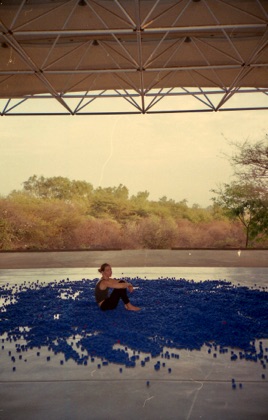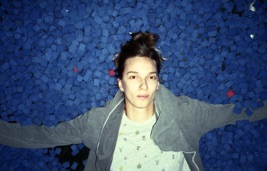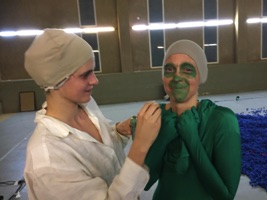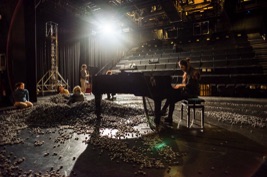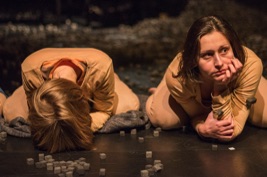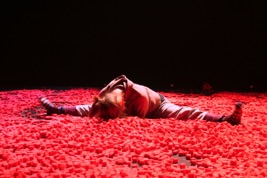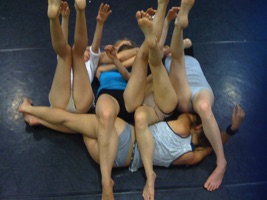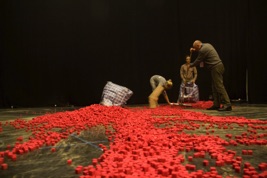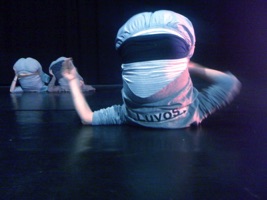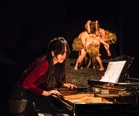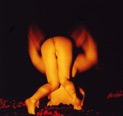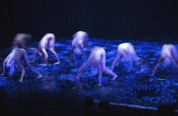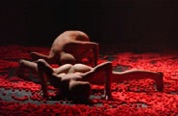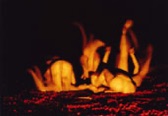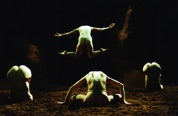LUVOSmove® - insights
Creating Luvos
“Some parts of the LUVOS practice are uneasy for the body, some positions are difficult or require a certain strenght or balance to hold. There are also some creatures that aren't straining but still might involve good technical skills. At the beginning of a rehearsal period we need much more effort to be in the positions and some parts come with pain. Especially in the moments when the body is in a distorted position for a longer time. After a couple of days the material starts to feel more organic and easier. For me it seems as if there were different technical sets of skills needed for Luvos – one challenge is to be able to perform the illusion, and a second challenge to do so without overstraining, to find ease and pleasure. Funnily, it seems impossible to skip the first period of embodying the material again, re-learning it.” (Martyna Lorenc)
“LUVOSmove® technique is a very demanding one for the body. Every time we re-start working on those movement qualities, I realize how different it is from the body training I normally do. It really needs time for the body to get back to those special qualities. Once you take time for this practice (rehearse), it becomes yours, and then you flow inside of the movement, still, it is not a „human” technique. What is difficult is that it requires very specific groups of muscles to be strong, and others to be soft. Because of many details, complications, strength which the work requires, it works best when you „take it easy” - do not push it, but let it go, and follow the energy with the group. Group feeling / community / solidarity is a very important aspect of that work. It is not about individuality, it is about group energy and listening. Possibly because our faces are not visible, this also erases the feeling of individuality and intensifies the feeling of community.” (Sonia Borkowicz)
“In the process of creating new material we are looking for body shapes that have the potential to lose human appearance and become an illusion of a strange form or another creature. They might resemble a living form in some way (we have names for them, like “elephants”, “spiders”, “flower”, “phalli”), or create an abstract form that defines itself. I think we never try to imitate a known shape.
Interesting shapes are usually found in an improvisation session together with a research of how the creature moves and behaves. Afterwards there is a large part of choreographic experimentation – is it appearing alone or in a group, is it stationary or moving through space, what is the interaction with others, etc.” (Martyna Lorenc)
"LUVOS is a universe of its own with its own body language. It abstracts myself as a performer and encourages me to use every corner of my body for expression, away from any conventional form of movement. Fingers become eyes, my buttocks become face, and I have to lose myself in the attempt to find expression without form. The work on LUVOSmove® pieces is a lot of research, trying, exploring in the LUVOS universe". (Anna Maria Müller)
Performing Luvos
"Big part of being able to perform the LUVOS material is understanding what makes the certain illusion, which exact shape, which movements belong to it, which movements will fascinate and make the audience curious about the creature and which might blur the image. An often appearing feedback during our rehearsals would be for movements to look “too human”. So being a LUVOS creature is definitely not human, maybe even not representing anything known. We look for foreign-looking shapes. Aliens. Very helpful in the feedback process is the use of the camera and watching the scenes from the perspective of the audience. It helps me relate my felt shape with the image I offer to the audience. Especially attended areas in our bodies when creating material are what is visible to the audience and I feel there is certain transformative process happening between assuming a shape and really becoming a living form or creature that behaves in a certain way. For that I feel we need to actively employ the imagination. There are often surprises – the movements appearing completely different to what we imagine they look like. In this sense, I feel in this work one has to keep connecting proprioceptive memory with the outside image.” (Martyna Lorenc)
During a LUVOS performance, I am at exposed to the lighting design and the eyes of the audience. It is not always easy to have the confidence that my bizarre shapes also convey what is desired. My own experience is completely different from that of the audience. I experience myself upside down, twisted and strained unaestheticly, while in the right light it looks like a praying mantis, a spider or a giant crab.
Physical closeness must not frighten you, the absolute acting as a team is important. It is not about me as an individual, but the common abstract is in the foreground. The eye from outside, the light, my body and the music interweave to an equal whole." (Anna Maria Müller)
„What is specific for me in performing LUVOS is that although we are present with our bodies on stage in proximity with the audience, there is no human identity involved. The faces are hidden throughout the performance so one does not identify with a performer of a specific look, gender, nationality etc, but instead identifies with a form, abstraction, other form of life. It's maybe a bit like interspecies communication. What I find beautiful in this work is when anthropocentrism gets lost.
What is special and enjoyable in performing LUVOS material is the togetherness and the union we need to create between us performers. In order to coordinate a creature that is constructed of all our bodies, we breathe together. We also whisper and communicate by sound signals. The choreography of the whole piece is build a lot on interrelationality and interdependence what makes it a joint venture rather than every person for themselves. The performance that we go through as performers is much different to what the audience sees, in that sense it reminds me sometimes of puppetry. So we, the performers, have a different show – with breaths, whispers, touches, and faces, than the audience for which the illusionary world is being created.” (Martyna Lorenc)
“Some parts of the movement in the choreography are clearly fixed, but there is a big part of them which has an idea / understanding / feeling which then flows in the group at the moment, knowing a structure, not knowing exact timing or positions. This adds aliveness and connection between the dancers to this work.” (Sonia Borkowicz)
